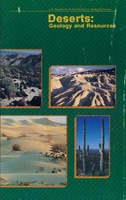Approximately one-third of the Earth's land surface is desert, arid land with meager rainfall that supports only sparse vegetation and a limited population of people and animals. Deserts stark, sometimes mysterious worlds have been portrayed as fascinating environments of adventure and exploration from narratives such as that of Lawrence of Arabia to movies such as "Dune." These arid regions are called deserts because they are dry. They may be hot, they may be cold. They may be regions of sand or vast areas of rocks and gravel peppered with occasional plants. But deserts are always dry. Deserts are natural laboratories in which to study the interactions of wind and sometimes water on the arid surfaces of planets. They contain valuable mineral deposits that were formed in the arid environment or that were exposed by erosion. Because deserts are dry, they are ideal places for human artifacts and fossils to be preserved. Deserts are also fragile environments. The misuse of these lands is a serious and growing problem in parts of our world.


